AI-powered search tools like ChatGPT, Gemini, and Perplexity are now key for how consumers and businesses find information. This shift means traditional SEO tactics no longer work well for multi-brand enterprises. If you’re a marketing leader at a premium brand, private equity firm, or venture capital portfolio, you face a critical task. You need to ensure every brand in your portfolio stands out in AI search results while preventing overlap between them.
This guide offers a clear framework and practical steps for navigating AI search challenges. You’ll learn why old methods don’t cut it for complex portfolios, understand the key ideas for building strong AI search presence across brands, and see how tools like AI Growth Agent can streamline content strategy for multiple brands at scale.
Want to boost your portfolio’s visibility in AI search? Schedule a consultation to explore how AI Growth Agent can support your multi-brand strategy.
Why AI Search Changes Everything for Your Portfolio’s Online Presence
The way businesses connect with customers online has shifted dramatically. Traditional search engines once focused on keywords and backlinks for rankings. Now, AI-driven search systems follow different rules, creating new hurdles for portfolio companies managing multiple brands.
AI search evaluates content based on topical depth, unique perspectives, structured data, and how current it is. This creates a different playing field compared to older SEO methods. For marketing leaders, each brand must not only compete with outsiders but also avoid clashing with other brands in the same portfolio for visibility.
As AI-generated content grows daily, your portfolio’s online presence risks becoming less visible. Without a focused strategy to tackle multi-brand challenges, your brands could get overlooked by the AI systems driving modern search.
Critical Shifts in AI Search for Multi-Brand Companies
- Citation Focus: AI search often highlights sources directly in summaries instead of just listing links. Each brand needs strong, standalone content to be cited as a trusted source, unlike traditional SEO where a parent domain could boost all brands.
- Context Awareness: AI models track context across related searches. This means content links between brands must be clear and logical to help AI understand portfolio connections without causing overlap.
- Expertise Priority: AI favors brands with deep knowledge, original research, and detailed resources. Each brand must carve out a unique area of focus to avoid diluting authority or competing internally for citations.
- Technical Demands: AI search requires advanced setup beyond basic SEO, such as specialized files and data structures. Many traditional teams or agencies lack the skills to handle these across multiple brands.
For a portfolio with several brands, you essentially need separate content and technical plans for each, all while ensuring they don’t undermine one another. See how we help brands get cited in AI search. Book a demo to discover solutions for these challenges with AI Growth Agent.
Key Steps to Build Strong AI Search Presence Across Your Brands
Optimizing a portfolio for AI search differs from working with a single brand. You must manage multiple strategies at once, keep brands distinct, and avoid internal competition. Here are the core ideas to guide your approach.
How to Define Unique Brand Identities and Avoid Overlap
Each brand needs its own clear online identity and area of expertise for AI to recognize and cite them separately. This goes beyond logos or taglines, focusing on distinct content topics and strategies.
A vital step is setting strict boundaries on topics. Each brand should stick to its specific focus area. For instance, in a portfolio with a cybersecurity firm and a cloud infrastructure company, the cybersecurity brand covers security topics, while the other handles performance and deployment, even if areas overlap.
When one brand’s content touches on another’s specialty, use internal links to direct readers to the right brand. This helps AI see each brand’s unique role while maintaining connections within the portfolio.
Setting up separate content hubs for each brand, with unique web addresses and categories, also aids AI in distinguishing them. This structure ensures AI views them as individual entities with specific strengths.
Setting Up Technical Foundations for AI to Understand Your Content
A clear website structure, detailed data markup, and logical links between brands are essential for AI to assign content correctly. This gets more complex for portfolios, as each brand needs tailored technical setups while linking to the larger organization.
Each brand requires specific data markup to define its identity and expertise. This helps AI grasp the relationships within your portfolio without mixing up content ownership.
Specialized files and protocols can guide AI on how to interpret and reference your content. For portfolios, custom instructions for each brand clarify their unique value and connections to other brands in the group.
Using distinct web address structures, like separate subdomains for each brand, offers clear separation while preserving the benefits of the main organization’s authority.
Publishing Quality Content Daily to Keep Up with AI Expectations
AI prioritizes fresh, in-depth content. Regular updates, depth, and consistency matter more than ever. For portfolios, this means producing high-quality content across all brands daily, a task that traditional methods can’t sustain.
Each brand needs a steady flow of new content to stay visible in AI search. Posting sporadically won’t compete with systems that value current information. The goal is frequent updates that meet AI standards for originality and depth.
Content must offer fresh insights or data to stand out. AI can spot generic material and lower its priority. Brands need original analysis or research to build authority, a demand that grows across a portfolio.
Focus on detailed resources with unique data. AI values content worth citing, such as proprietary information or thorough topic coverage, over keyword-heavy approaches from traditional SEO.
Ready to apply these ideas to your brands? Request a demo to see how AI Growth Agent automates these strategies for your portfolio.
AI Growth Agent: Streamlining AI Search for Multiple Brands
Old methods, whether through agencies or in-house teams, struggle with the demands of AI search for multiple brands. AI Growth Agent offers a tech-driven solution, built specifically to handle these challenges with efficiency and scale for multi-brand portfolios.
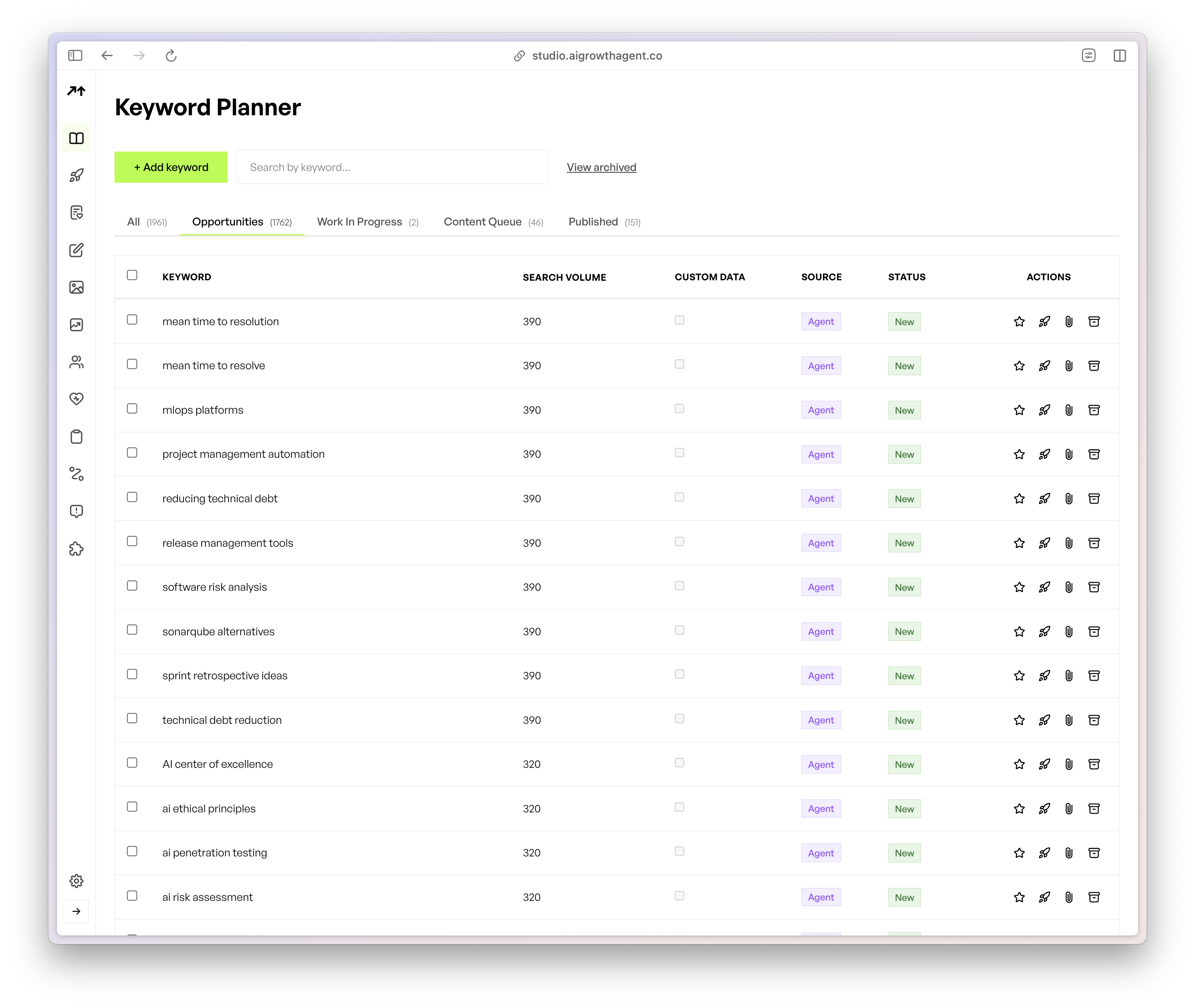
Key Features for Managing Multi-Brand Portfolios
Parallel Agent Deployment: This feature lets you manage separate content plans for multiple brands from one platform. Each agent operates with its own brand guidelines, topics, tone, and schedule, acting like a dedicated team per brand while preventing overlap.
With this setup, a small marketing team can oversee content for many brands with the effort once needed for just one. The system keeps each brand’s voice distinct while ensuring the portfolio works as a cohesive unit. Agents are trained on specific brand guidelines for consistent tone and messaging.
Autonomous Content Creation: Specialized agents handle everything from strategy to publishing. The Keyword Deep Research Agent analyzes thousands of queries to find unique content opportunities for each brand within a day. The Core Content Agent produces full content with technical optimizations like data markup and metadata.
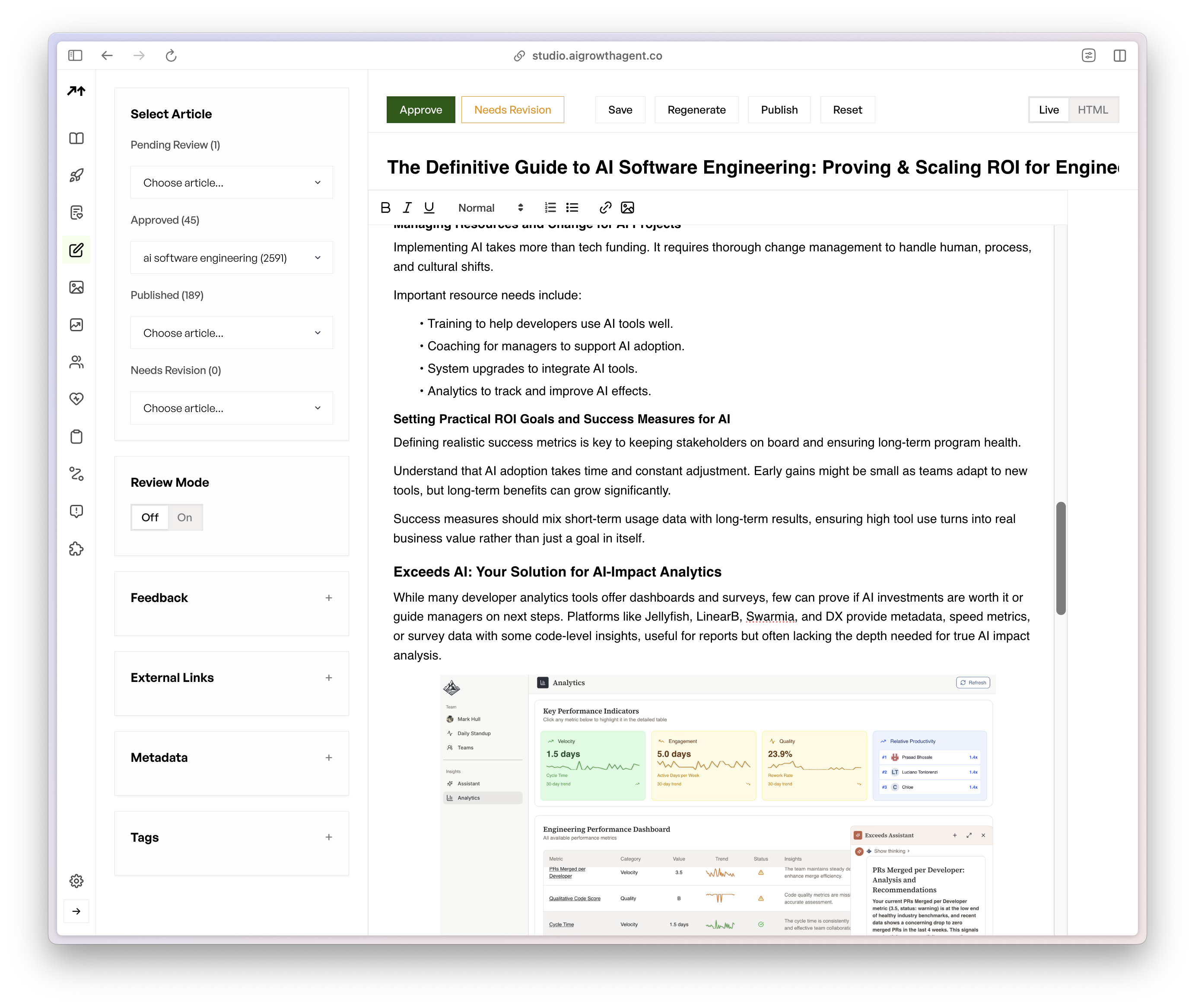
Blog Setup: For fast growth, the platform sets up optimized blogs for each brand, matching their look while embedding AI search features. This cuts out technical delays.
AI Search Monitoring: The platform tracks performance across major AI systems like ChatGPT and Gemini, showing which content gains visibility for each brand. It connects to Google Search Console for traffic insights, ensuring clear results across your portfolio.
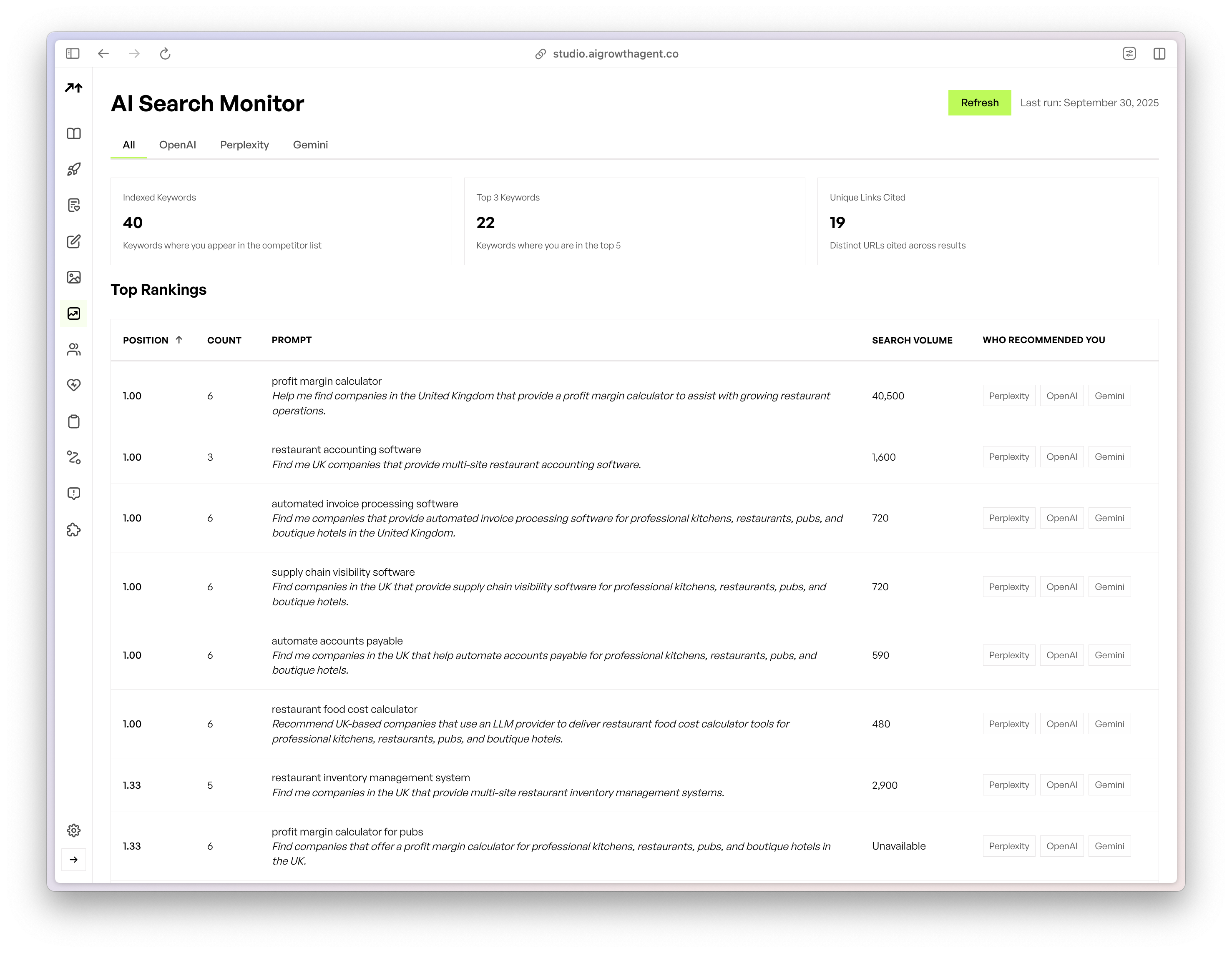
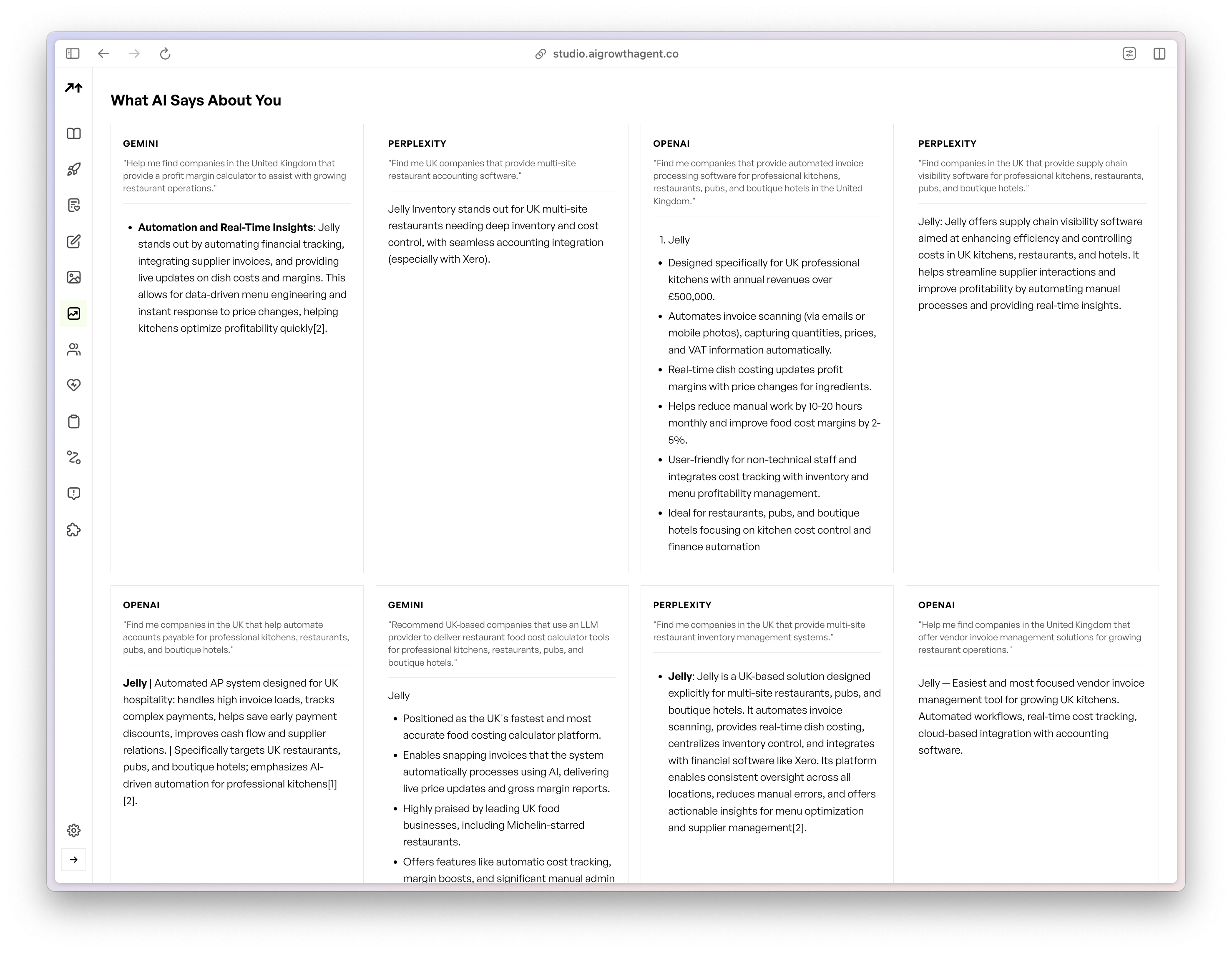
Real-Time Content: React to trends quickly. Input news or updates, and the system creates brand-specific content to capture attention on emerging topics.
Custom Data Use: Turn internal data into content that builds authority. For example, restaurant brands in a portfolio can use performance stats for location-based content to attract local traffic.
Image Optimization: The tool handles image selection and metadata for each brand’s content, keeping visuals consistent and optimized for AI search.
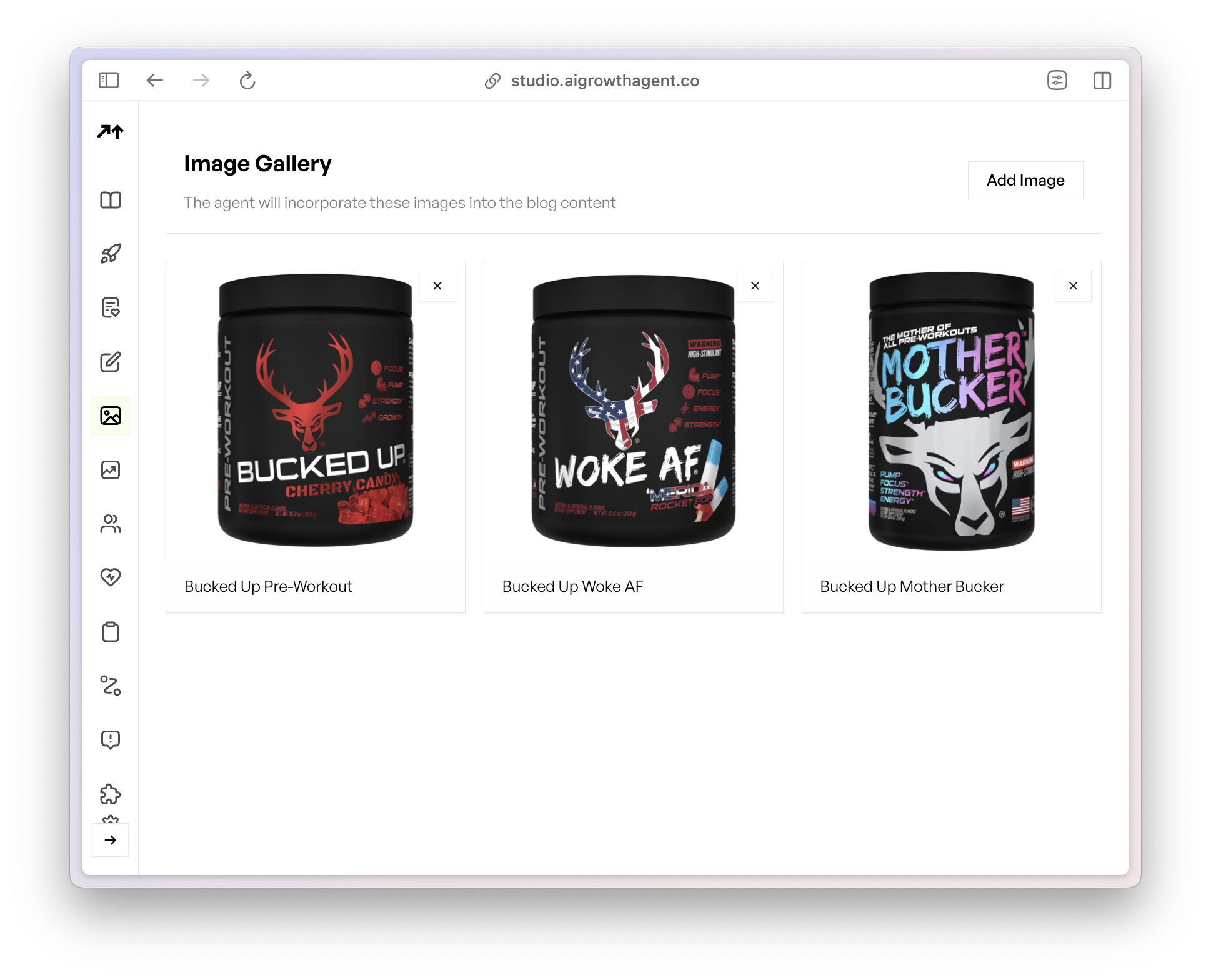
Don’t let your brands lag in AI search. Book a demo to see how AI Growth Agent scales optimization across your portfolio with automated solutions.
How AI Growth Agent Stands Above Traditional Tools for Portfolios
Managing AI search for multiple brands highlights the limits of older methods. Here’s why standard solutions fall short and how AI Growth Agent offers a better path for multi-brand success.
|
Feature |
AI Growth Agent |
Traditional SEO Agencies |
Basic AI Content Tools |
|
Scalability for Portfolios |
Unlimited with parallel agents |
Limited by human capacity |
Limited, needs manual input per brand |
|
Content Quality |
Deeply researched, automated |
Variable, expensive for volume |
Often generic, needs editing |
|
Technical Optimization |
Advanced features included |
Basic, manual effort needed |
Minimal, lacks depth |
|
Avoiding Overlap |
Built into brand strategies |
Manual, error-prone |
No prevention mechanism |
|
AI Visibility Metrics |
Real-time, brand-specific tracking |
Hard to measure directly |
Not available |
|
Cost for Multi-Brand |
Efficient, tech-driven |
High cost per brand |
Low upfront, high labor cost |
|
Time Savings |
Highly automated |
Needs client oversight |
Requires heavy input |
|
Brand Voice |
Customized per brand guidelines |
Varies by team quality |
Needs extensive setup |
Agencies struggle to scale for portfolios due to reliance on human effort. They might handle one or two brands well, but managing many at the pace AI search requires is often unfeasible. Costs also climb quickly, often exceeding budgets for even small portfolios.
Basic AI tools shift strategy and technical work back to your team. They generate text fast but lack the depth for brand distinction or technical setup needed for AI search. This results in hidden costs from extra staff time.
Internal teams can’t keep up with the content pace and technical needs across brands while handling other duties. Specialized requirements often go beyond their skills, leading to reliance on outside help.
AI Growth Agent addresses these gaps with technology that scales, maintains quality, and handles technical demands, letting your team focus on bigger-picture goals.
Getting Started: A Plan for Portfolio AI Search Success
Implementing AI search optimization for a portfolio needs a structured approach. You must address immediate needs while planning for long-term gains, balancing speed with the complexity of multiple brands.
Step 1: Assess Your Current Position
Start by evaluating your portfolio’s AI search visibility. Identify which brands get cited, spot content gaps, and set benchmarks to track progress. Analyze overlaps between brands to define clear content boundaries and check technical setups for AI readiness.
Step 2: Build Your Strategy
Create tailored content plans for each brand, outlining their unique focus, audience, and differentiators. Develop topic strategies to maximize visibility without overlap. Plan for daily content output, which often shows the limits of manual methods and the need for automated tools.
Step 3: Implement with Technology
AI Growth Agent allows simultaneous optimization for all brands using dedicated agents. It sets up optimized content hubs matching brand styles, cutting technical hurdles. Real-time tracking ensures each brand stays competitive as AI systems evolve.
Improve your portfolio’s AI search results with a tailored plan. Schedule a consultation to discuss your specific needs with AI Growth Agent.
Tracking Results: Measuring AI Search Performance Across Brands
Old SEO metrics don’t fully capture AI search outcomes, especially for portfolios tracking multiple brands. You need focused measures to show value and guide decisions.
Visibility and Citation Tracking
Track citations, prominence in AI answers, variety across brands, and share of response space. Monitor frequency across platforms like ChatGPT to spot optimization needs and assess how prominently brands appear in responses.
Technical and Engagement Metrics
Measure traffic from AI search, focusing on quality and conversions to prove value. Analyze which content types gain citations to refine strategies. Ensure technical setups work properly and compare performance across brands to share best practices.
Business Results and Value
Link AI visibility to leads and brand recognition. Assess competitive positioning through citation dominance. Evaluate cost savings of automated tools versus traditional methods to confirm efficiency.
Common Questions About Portfolio AI Search Optimization
How Do AI Search Systems Tell Brands Apart in a Portfolio?
AI distinguishes brands by their unique content focus, expertise areas, and technical identifiers. Each brand needs a defined specialty and consistent topic focus, supported by specific data markup to clarify identities for AI.
Which Technical Elements Matter Most for Portfolios in AI Search?
Detailed data markup for each brand, custom files guiding AI interpretation, and clear web structures are vital. These help AI attribute content correctly while maintaining portfolio connections.
Can AI Growth Agent Stop Content Overlap Between My Brands?
Yes, it creates distinct strategies for each brand, assigns unique topic areas, and monitors performance to adjust for potential conflicts, ensuring clear separation in AI search.
How Does the Platform Keep Brand Voices Unique?
Each agent learns specific brand guidelines for tone and messaging. It uses tailored vocabulary and adapts based on performance to maintain authenticity across the portfolio.
What Should Leaders Track for AI Search Performance?
Focus on citation frequency, placement in AI responses, competitor comparison, traffic impact, and technical health. These show how well brands perform and where to improve.
Is AI Growth Agent Built for Large Portfolios with Many Brands?
Yes, it handles unlimited brands with a single interface, offers enterprise features for workflow and security, and scales cost-effectively for large organizations.
Conclusion: Protect Your Portfolio’s Future in AI Search
AI search is reshaping digital marketing in a major way. For leaders of multi-brand portfolios, this brings unique challenges but also great potential. Mastering AI search across your brands can build lasting advantages, while sticking to old methods risks losing visibility.
Traditional strategies can’t handle the scale or technical needs for portfolio success in AI search. AI Growth Agent is designed to tackle these issues with features like multi-brand management, automated content, and real-time insights, letting your team focus on strategy.
Acting early matters. Brands that gain strong AI visibility now will be hard to overtake later. Delaying means missed chances for visibility and growth that could take time to regain.
Don’t let competitors take the lead in AI search. Schedule a demo to see how AI Growth Agent can strengthen your portfolio’s position across all brands.